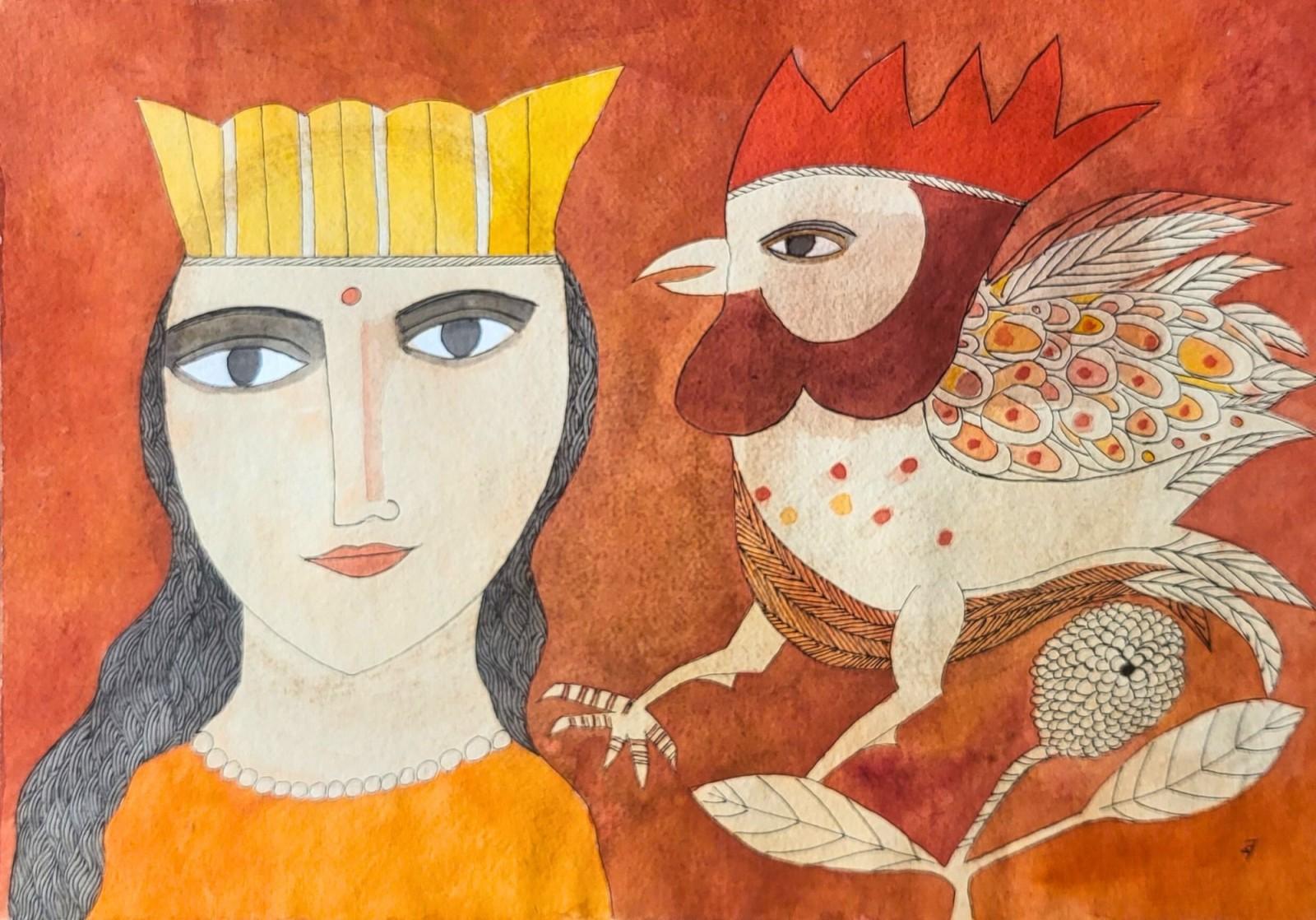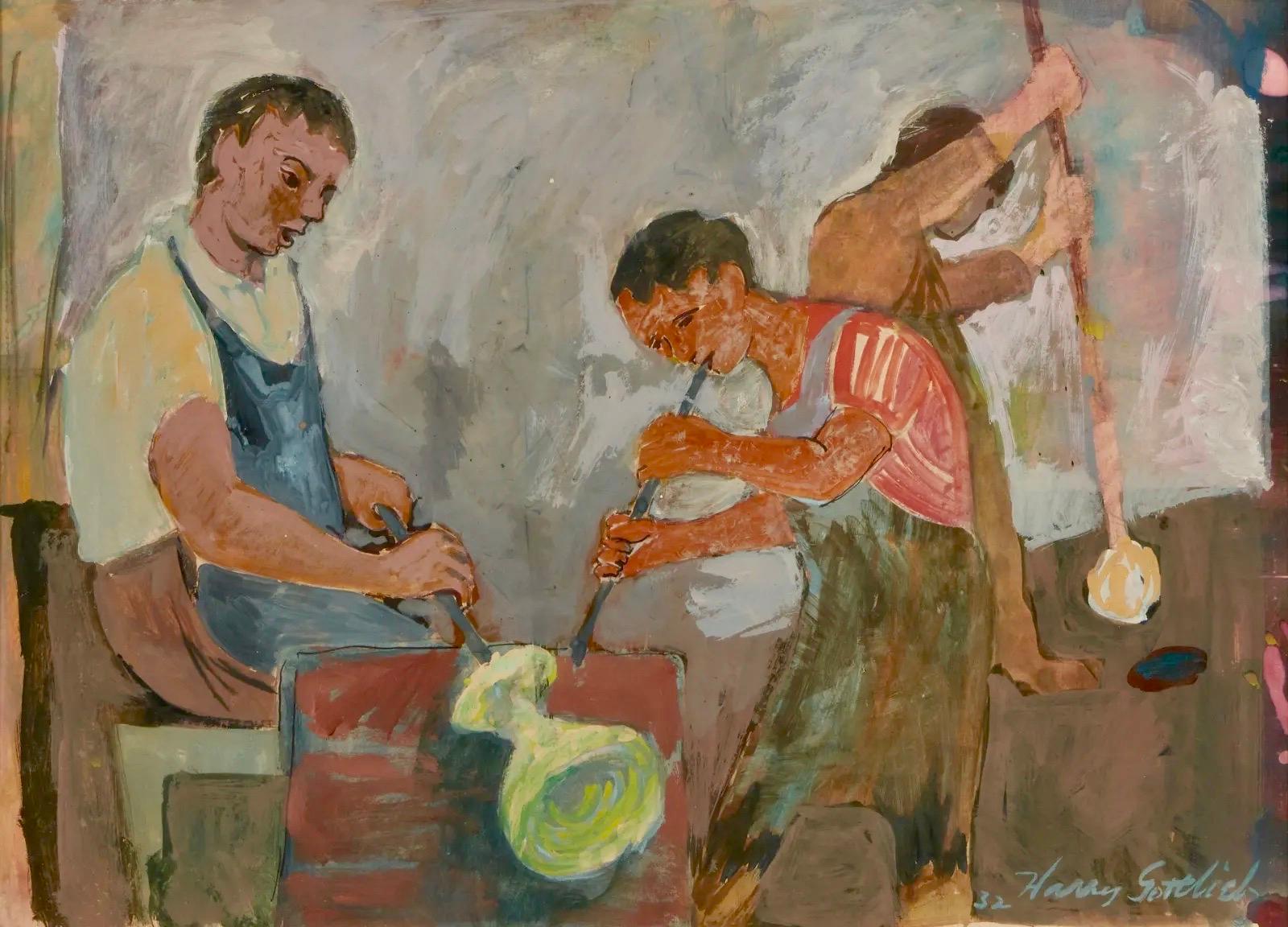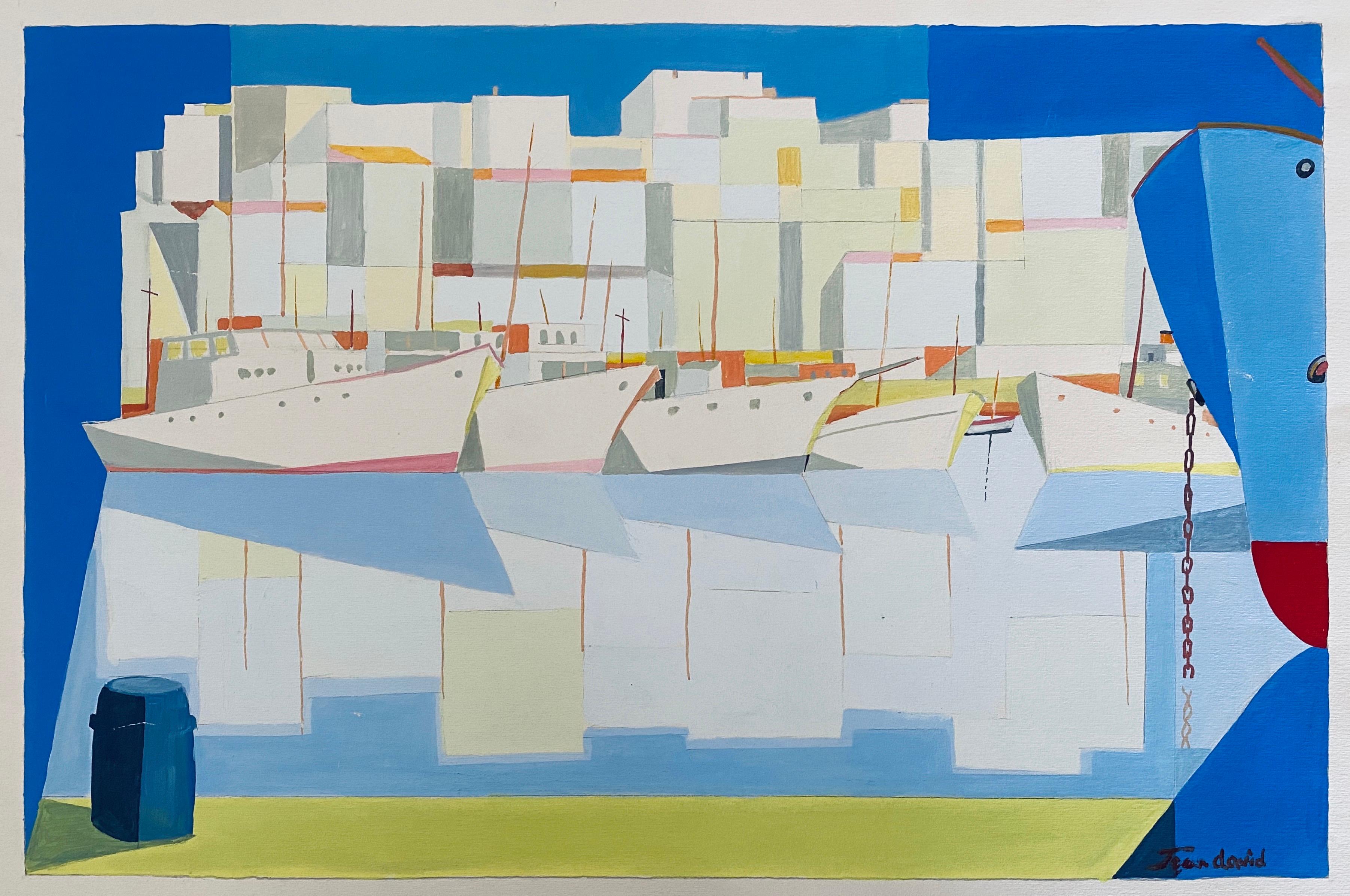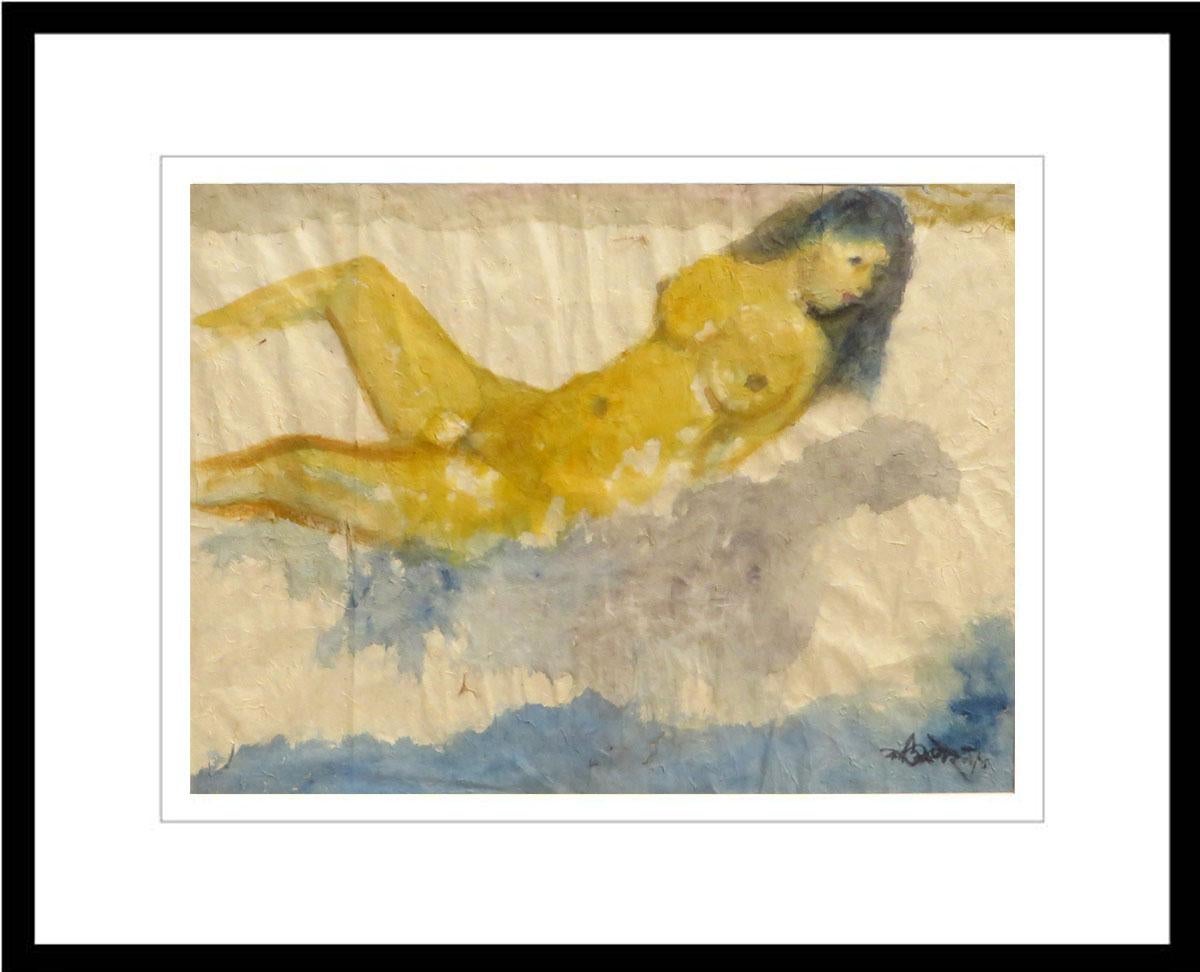Items Similar to Old Man, Watercolor on paper, Brown, Green, Blue, Modern Indian Artist"In Stock"
Want more images or videos?
Request additional images or videos from the seller
1 of 10
Shyamal Dutta RayOld Man, Watercolor on paper, Brown, Green, Blue, Modern Indian Artist"In Stock"2002
2002
About the Item
Shyamal Dutta Ray - Untitled - 10 x 14 inches or 25.4 x 35.56 cm (unframed size)
Watercolor on paper
Signed (LR) in Bengali & Dated.
Temple and Chariot: City life of Calcutta, surrealism, acrylic in bright yellow, red, white by Modern Indian Artist Shyamal Dutta Ray.
Style : The poignant imagery in Shyamal Dutta Ray’s paintings stem from his personal experiences and his canvases reflect his attempts to render the complex visual world around him. Most of Ray’s work reflects the city life of Calcutta, with its happiness and sorrow, struggle and strife, poverty and hope. The works also exhibit a sense of irony, surrealism and awareness of a disintegrating society.
About the Artist and his work :
Born : Ranchi, Bihar in 1934.
Education : He graduated from the Government College of Art and Craft in 1955.
Career : Dutta Roy worked as art teacher at Jagadbhandu Institution in Calcutta.
Art Career :
Regarded as a master watercolourist, Ray is also a founding member of the Society of Contemporary Artists, an artists’ collective, that sought to introduce innovativeness into the art world of the 1960s.
Shyamal Dutta Ray’s body of work constitutes a major turning point in the history of the Bengal school of art. Ray is credited with adding depth and intensity to the medium of watercolours, at a time when the Bengal school of Art traditionally used light and watery colours. His melancholic and pensive works reflect the contradictions of life around him.
Selected Group Exhibitions:
2014 - Indian Divine: Gods & Goddesses in 19th and 20th Century Modern Art, DAG Modern, New Delhi, India.
2012 - Manisfestions VIII- 20th certury Indian Art, DAG Modern, New Delhi, India.
2011 - Reprise - 2011, Aicon Gallery, New York, USA, Greenwich Village.
2010 - Figure/Landscape: Part Two, Aicon Gallery, London, UK, Mayfair.
2009 - Tracing TIme, Works on Paper, Bodhi Art, Mumbai - Kalaghoda, India, Kala Ghoda.
The artist passed away, but his work has continued to be posthumously exhibited. From 2006 to 2008, he was featured in two shows at Aicon Gallery, in New York.
Honours and Awards :
1958 - Gold Medal, Academy of Fine Art, Kolkata
1968 - Rabindra Bharati University Award, Kolkata
1968 - Founder Member, Group 8, Kolkata
1972,73,75,78 - Birla academy of Art and Culture, Kolkata
1982 - National Award, Lalit Kala Akademi, Delhi
1988 - Karnataka Chitrakala Parishath, Bangalore
1988 - Awarded Shiromoni Puraskar.
Collections : His works are in the collections of the National Gallery of Modern Art, Delhi, the Victoria and Albert Museum, London and the Glenbarra Museum, Japan.
Death : 2005.
- Creator:Shyamal Dutta Ray (1934 - 2005, Indian)
- Creation Year:2002
- Dimensions:Height: 18 in (45.72 cm)Width: 22 in (55.88 cm)Depth: 1 in (2.54 cm)
- Medium:
- Movement & Style:
- Period:
- Condition:
- Gallery Location:Kolkata, IN
- Reference Number:1stDibs: LU60436406642
About the Seller
4.9
Vetted Seller
These experienced sellers undergo a comprehensive evaluation by our team of in-house experts.
Established in 2004
1stDibs seller since 2017
119 sales on 1stDibs
Typical response time: 13 hours
- ShippingRetrieving quote...Ships From: Kolkata, India
- Return PolicyA return for this item may be initiated within 7 days of delivery.
More From This SellerView All
- The Cockerel, Water colour on Paper Grey, Red by Indian Artist"In Stock"By Badri NarayanLocated in Kolkata, West BengalBadrinarayan The Cockerel Water colour on Paper 22 x 14 inches 55.8 x 35.5 cm This work features in the Book on Badrinarayan Written by Ms. Prema Vishwanathan & Published by Ma...Category
20th Century Modern Figurative Paintings
MaterialsPaper, Watercolor
- Nude Woman Bathing, Reclining, Watercolor, Blue, Yellow by K.C. Pyne "In Stock"By Kartick Chandra PyneLocated in Kolkata, West BengalKartick Chandra Pyne - Untitled - 18 x 29 inches ( unframed size without mount ) Watercolor on rice paper Signed in Bengali Lower right. This would will be shipped mounted without th...Category
Early 2000s Modern Nude Paintings
MaterialsPaper, Rice Paper, Watercolor
- The Flower Water colour on Paper Grey, Brown by Indian Artist"In Stock"By Badri NarayanLocated in Kolkata, West BengalBadri Narayan The Flower Water colour on Paper 8 x 8 inches 20.3 x 20.3 cm 8th April 1993 ( Framed & Delivered ) This work features in the Book on Badrinarayan Written by Ms. ...Category
Early 19th Century Modern Figurative Paintings
MaterialsWatercolor, Paper
- Head, Ink & Watercolour on Paper by Indian Artist Sunil Das "In Stock"By Sunil DasLocated in Kolkata, West BengalSunil Das - Head, Ink & Watercolour on paper - 11 x 17.25 inches (unframed size) Free Shipping Without Frame Sunil Das (1939-2015) was a Master Modern Indian Artist from Bengal. Ex...Category
Early 2000s Modern Figurative Drawings and Watercolors
MaterialsInk, Watercolor, Paper, Charcoal
- Untitled, Watercolour on Paper, by Modern Indian Artist "In Stock"By Shyamal Dutta RayLocated in Kolkata, West BengalShyamal Dutta Ray - Untitled - 19 x 24 inches (unframed size) Watercolor on Paper Signed Style : The poignant imagery in Shyamal Dutta Ray’s paintings stem from his personal experie...Category
Early 2000s Modern Figurative Paintings
MaterialsPaper, Watercolor
- Fish, Watercolor on paper, Yellow, Blue, Green by Master Artist "In Stock"By Kartick Chandra PyneLocated in Kolkata, West BengalKartick Chandra Pyne - Untitled - 18 x 24 inches ( unframed size) Watercolor on thick imported paper Inclusive of shipment in roll form. Style : After graduating from the Governmen...Category
Early 2000s Modern Animal Paintings
MaterialsWatercolor, Paper
You May Also Like
- Glassblowers WPA American Scene Mid- 20th Century Modern Figurative Workers 1932By Harry GottliebLocated in New York, NYGlassblowers WPA American Scene Mid- 20th Century Modern Figurative Workers. Dated and signed "32 Harry Gottlieb" lower right. Sight: 13 1/8" H x 18 1/4" W. Harry Gottlieb, painter, screenprinter, educator, and lithographer, was born in Bucharest, Rumania. He emigrated to America in 1907, and his family settled in Minneapolis. From 1915 to 1917, Gottlieb attended the Minneapolis Institute of Arts. After a short stint as an illustrator for the U.S. Navy, Gottlieb moved to New York City; he became a scenic and costume designer for Eugene O"Neill's Provincetown Theater Group. He also studied at the Philadelphia Academy of Fine Arts and the National Academy of Design. He was one of America's first Social Realist painters, influenced by that Robert Henri-led movement in New York City where Gottlieb settled in 1918. He was also a pioneer in screen printing, which he learned while working for the WPA. He married Eugenie Gershoy, and the couple joined the artist colony at Woodstock, New York. He lectured widely on art education. In 1923, Gottlieb settled in Woodstock, New York and in 1931, spent a a year abroad studying under a Guggenheim Fellowship. In 1935, he joined the Federal Art Project...Category
1930s American Modern Figurative Paintings
MaterialsPaper, Gouache
- Romanian Modernist Gouache Painting Of Buildings And Boats - Jean DavidBy Jean DavidLocated in Surfside, FLJean David was a painter and designer, known for his contributions to the Romanian avant-garde and to the early modernist art of Israel (then recently founded). He was the first Israeli artist to be inducted into the illustrious Alliance Graphique Nationale in 1954. He had studied between 1927 and 1937 at various art academies in Paris. In 1929 he participated for the first time at a collective exhibition in Bucharest and in 1933 he had his first personal exhibition (in the same city). In the early '30s he was a member of the Surrealist group "unu" (meaning "one"). In 1942, he left Romania in a boat with 12 other Jews, including Theodor Brauner, the brother of Victor Brauner. After being captured by British authorities in Cyprus, he managed to reach Palestine in 1944. In 1949 he went to live in Jerusalem, where he was active in developing ceramic arts, sculpture works in copper, and artistic tapestry wall hangings under the auspices of the Ministry of Trade and Industry. Together with Marcel Janco, he founded in Israel the artist village known as Ein Hod. He also gained much reputation as a muralist and graphic and poster designer, having designed numerous posters and other works for the El Al air company, Maccabiah games, Zim shipping and The Israel tourist industry. David’s primary importance was in the design of posters. He used a wildly colorful decorative style in his art, which combined illustration, caricature, and national figures. In addition he designed wall hangings for “Maskit,” and also worked in the decoration of public buildings. His paintings had elements of Surrealism and included images from nature and landscapes. Similar in style to David Klein and the Polish Cyrk posters. Forms From Israel, Mounting Exhibition, USA, 1958 Artists: El Hanani (Sapozhnikow), Arie Azaz, Nehemiah Boris Carmi, Hanna Harag Zunz, David, Jean David Gumbel, Keiner Forcheimer, Julia Mansfeld, Al Merom, Peter Mayer, Jean Palombo...Category
Mid-20th Century Modern Figurative Paintings
MaterialsGouache, Paper
- Chicago Jewish Modernist Judaica Painting Simchat Torah WPA Artist Israeli FlagsBy Alexander Raymond KatzLocated in Surfside, FLThis has young ISraeli pioneers dancing with the flag as typical of works of the late British mandate Palestine era early state of Israel. Genre: Modern Subject: Figurative (stained glass style) Medium: Mixed media gouache on paper Hand signed lower left Alexander Raymond Katz, Hungarian / American (1895 – 1974) Alexander Raymond Katz was born in Kassa, Hungary, and came to the United States in 1909. He studied at the Art Institute of Chicago and the Chicago Academy of Fine Arts. In the late 1920s, he worked as a director of the Poster Department at Paramount Studios. He was appointed the Director of Posters for the Chicago Civic Opera in 1930. During the Great Depression, notable architect Frank Lloyd Wright urged Katz to become a muralist. In 1933, he was commissioned to paint a mural for the Century of Progress exposition in Chicago. In 1936, he painted the mural History of the Immigrant for the Madison, Ill., post office. Katz’s works were included in various exhibitions and now are part of several museum collections, including those of the Art Institute of Chicago; Corcoran Gallery of Art, Washington, D.C.; and the Jewish Museum, New York. His murals, bas-reliefs and stained glass designs adorn more than 200 Jewish synagogues in the United States. Katz and other Jewish artists in Chicago who expressed Jewish and Biblical themes were inspired by the artist Abel Pann (1883-1963). Pann, who is regarded as the leading painter of the Land of Israel, exhibited in the Art Institute of Chicago in 1920. Early in his career, Katz began to explore the artistic possibilities inherent in the characters of the Hebrew alphabet. He developed aesthetic and philosophical interpretations of each letter and became the leading innovator and pioneer in the field of Hebraic art. Katz applies this concept in the woodcut Moses and the Burning Bush. Hebrew letters appears in Moses’ head, his cane and inside the flame. The initial of Moses’ name crowns his head. The letter in the flame is the first letter of the name of God. A combination of images and Hebrew letters appeared commonly in illustrations of the scene Moses and the Burning Bush in the Haggadah, the book of Passover. The symbolism of the burning bush corresponds to the motifs of A Gift to Biro-Bidjan. Among the fourteen participating artists were notable Chicago modernists Todros Geller, Mitchell Siporin...Category
Mid-20th Century Modern Figurative Paintings
MaterialsPaper, Gouache
- Rare Modernist Hungarian Rabbi Pastel Drawing Gouache Painting Judaica Art DecoBy Hugó ScheiberLocated in Surfside, FLRabbi in the synagogue at prayer wearing tallit and tefillin. Hugó Scheiber (born 29 September 1873 in Budapest – died there 7 March 1950) was a Hungarian modernist painter. Hugo Scheiber was brought from Budapest to Vienna at the age of eight where his father worked as a sign painter for the Prater Theater. At fifteen, he returned with his family to Budapest and began working during the day to help support them and attending painting classes at the School of Design in the evening, where Henrik Papp was one of his teachers. He completed his studies in 1900. His work was at first in a post-Impressionistic style but from 1910 onward showed his increasing interest in German Expressionism and Futurism. This made it of little interest to the conservative Hungarian art establishment. However, in 1915 he met the great Italian avant-gardist Filippo Tommaso Marinetti and the two painters became close friends. Marinetti invited him to join the Futurist Movement. The uniquely modernist style that he developed was, however, closer to German Expressionism than to Futurism and eventually drifted toward an international art deco manner similar to Erté's. In 1919, he and his friend Béla Kádar held an exhibition at the Hevesy Salon in Vienna. It was a great success and at last caused the Budapest Art Museum to acquire some of Scheiber's drawings. Encouraged, Scheiber came back to live in Vienna in 1920. A turning point in Scheiber's career came a year later, when Herwarth Walden, founder of Germany's leading avant-garde periodical, Der Sturm, and of the Sturm Gallery in Berlin, became interested in Scheiber's work. Scheiber moved to Berlin in 1922, and his paintings soon appeared regularly in Walden's magazine and elsewhere. Exhibitions of his work followed in London, Rome, La Paz, and New York. Scheiber's move to Germany coincided with a significant exodus of Hungarian artists to Berlin, including Laszlo Moholy-Nagy and Sandor Bortnyik. There had been a major split in ideology among the Hungarian avant-garde. The Constructivist and leader of the Hungarian avantgarde, Lajos Kassák (painted by Hugó Scheiber in 1930) believed that art should relate to all the needs of contemporary humankind. Thus he refused to compromise the purity of his style to reflect the demands of either the ruling class or socialists and communists. The other camp believed that an artist should be a figurehead for social and political change. The fall out and factions that resulted from this politicisation resulted in most of the Hungarian avant gardists leaving Vienna for Berlin. Hungarian émigrés made up one of the largest minority groups in the German capital and the influx of their painters had a significant effect on Hungarian and international art. Another turning point of Scheiber's career came in 1926, with the New York exhibition of the Société Anonyme, organized by Katherine Dreier. Scheiber and other important avant garde artists from more than twenty-three countries were represented. In 1933, Scheiber was invited by Marinetti to participate in the great meeting of the Futurists held in Rome in late April 1933, Mostra Nazionale d’Arte Futurista where he was received with great enthusiasm. Gradually, the Hungarian artists began to return home, particularly with the rise of Nazism in Germany. Kádar went back from Berlin in about 1932 and Scheiber followed in 1934. He was then at the peak of his powers and had a special flair in depicting café and cabaret life in vivid colors, sturdily abstracted forms and spontaneous brush strokes. Scheiber depicted cosmopolitan modern life using stylized shapes and expressive colors. His preferred subjects were cabaret and street scenes, jazz musicians, flappers, and a series of self-portraits (usually with a cigar). his principal media being gouache and oil. He was a member of the prestigious New Society of Artists (KUT—Képzőművészek Új Társasága)and seems to have weathered Hungary's post–World War II transition to state-communism without difficulty. He continued to be well regarded, eventually even receiving the posthumous honor of having one of his images used for a Russian Soviet postage stamp (see image above). Hugó Scheiber died in Budapest in 1950. Paintings by Hugó Scheiber form part of permanent museum collections in Budapest (Hungarian National Museum), Pecs (Jannus Pannonius Museum), Vienna, New York, Bern and elsewhere. His work has also been shown in many important exhibitions, including: "The Nell Walden Collection," Kunsthaus Zürich (1945) "Collection of the Société Anonyme," Yale University Art Gallery, New Haven, Connecticut (1950) "Hugó Scheiber: A Commemorative Exhibition," Hungarian National Museum, Budapest (1964) "Ungarische Avantgarde," Galleria del Levante, Munich (1971) "Paris-Berlin 1900-1930," Centre Georges Pompidou, Paris (1978) "L’Art en Hongrie, 1905-1920," Musée d’Art et l’Industrie, Saint-Etienne (1980) "Ungarische Avantgarde in der Weimarer Republik," Marburg (1986) "Modernizmus," Eresz & Maklary Gallery, Budapest (2006) "Hugó Scheiber & Béla Kádár," Galerie le Minotaure, Paris and Tel Aviv (2007) Hugó Scheiber's paintings continue to be regularly sold at Sotheby's, Christie's, Gillen's Arts (London), Papillon Gallery (Los Angeles) and other auction houses. He was included in the exhibition The Art Of Modern Hungary 1931 and other exhibitions along with Vilmos Novak Aba, Count Julius Batthyany, Pal Bor, Bela Buky, Denes Csanky, Istvan Csok, Bela Czobel, Peter Di Gabor, Bela Ivanyi Grunwald, Baron Ferenc Hatvany, Lipot Herman, Odon Marffy, C. Pal Molnar...Category
Early 20th Century Modern Figurative Paintings
MaterialsPaper, Charcoal, Pastel, Watercolor, Gouache
- Society of Six Street Scene - Figurative AbstractBy Bernard Von EichmanLocated in Soquel, CAStunning New York City urban modernist watercolor titled "Summer Afternoon Stroll" by Society of Six artist Bernard Von Eichman (American, 1899-1990), 1...Category
1930s American Modern Landscape Paintings
MaterialsArchival Paper, Watercolor
- Watercolor of a Market Scene by Walter PeregoyBy Walter PeregoyLocated in Pasadena, CACharming watercolor watercolor of a market in a village interpreted and signed by Walter Peregoy, American painter acclaimed for his avant-garde style. Walter Peregoy was born in Los...Category
Mid-20th Century Modern Paintings
MaterialsPaper, Wood, Watercolor





